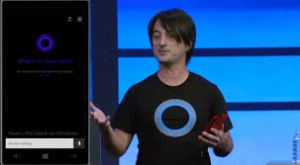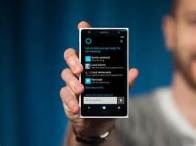
“Some may contend no one wants a phone that big. This is true. But many people do want a tablet that small. It’s all about how this 7” Surface is positioned and marketed.” – Jason L Ward
Rumors, Rumors Rumors
Early last year rumors began to spill that Microsoft was soon to release a new entry into it’s now popular line of hybrid tablets. The productivity powerhouse “tablet that can replace your laptop” – the Microsoft Surface – would soon have a diminutive little brother, the Surface Mini. The Surface Mini was expected to release by the fall of 2014. But alas, Microsoft deemed that not all pieces were yet in place to ensure the proper positioning of this 7″ to 8″ note-taking focused device.
Size Matters

Last night 1/26/15 at 5:55pm EST Joe Belfiore tweeted “8” (or) bigger for full desktop, going forward on new PCs. The one I showed was 8″”. This was in response to questions regarding what version of Windows 10 would be found on what device sizes. It is now clear that the form factor agnostic Windows 10 OS will be represented on 8” and above tablets with the continuum enhanced full desktop toting version while 7” and smaller devices (tablet and phones) will be sporting the full Modern UI sans the desktop.
We have been hearing that the RT ARM based SKU of Windows would be being replaced by a new ARM based SKU that would run phones and small tablets. It looks as if 7” is the threshold for this particular SKU.
Positioning
As noted above the Redmond companies initial plans for a 2014 launch of a Surface Mini were halted (or postponed) because not all factors were in line to ensure a distinct market positioning for such a device. So what’s different this year? In a nutshell Windows 10. As we know Windows 10 is a single OS that supports a family of devices. This provides users with a common experience across devices of varying form factors, from PCs, to laptops and even phones. With additional cloud based services that are built into the OS like Office 365, One Drive and One Note users are provided with a seamless experience for their personal and professional data and multimedia. A Surface Mini with Windows 10 fits well within this ecosystem paradigm. More on that in a moment.
The Surface line of tablets, which are positioned in the market as competitors to devices such as the MacBook have pioneered a path for Microsoft’s hybrid OS on an equally versatile piece of well-designed hardware. With the ability to function as a touch friendly tablet with access to thousands of Modern apps one moment, and with the snap of a keyboard, via continuum, transform into a productive “Ultrabook” with easy access to the legacy desktop and it’s host of millions of legacy software the Surface, particularly the Surface Pro 3, has carved out a position for Microsoft’s hybrid productivity aspirations.
Key Factors
For devices of a particular size (above 8” – ideally 10”- 12”), such as the Intel based Surface, where targeted productivity tasks would require a full workstation, the keyboard is an integral and powerful accessory. Microsoft has been deliberate in communicating this. Via early ads that focused on the distinctive “CLICK” of the keyboard when locked in place, to ads of exuberant dancers locking and docking the Surface keyboard in place Microsoft has made a point that the keyboard is key to the productivity purposes of the current participants in their Surface line of tablets. That is not to belittle the powerful position of the One Note initiating N-Trig pen, but as far as accessories and market positioning go for the larger precursors to the coming Mini, productivity means keyboard.
Enter the Mini
The Surface Mini I believe will fall into the 7” ARM based realm of devices running Windows 10. The SKU shared by what is currently called Windows Phone. At 7”, though possible to connect to a keyboard, this size is not ideal for keyboard intensive productivity tasks. The display is too small for long term typing and productivity tasks in a sedentary position. Microsoft already has that part of the market covered anyway, with devices well suited for such tasks via the Surface Pro 3. A device which has a pen (rather than keyboard) as its primary accessory and data entry method (beyond the finger) is not, however, a space Microsoft has filled.
This is where a 7” Surface Mini can shine. With a touch friendly version of Office set to debut as free software on all small tablets and phones the 7 inch Surface Mini will be a powerful tool for creating and editing full Word, Excel and even PowerPoint documents. With an accompanying digitizer pen the experience with navigating and annotating documents will be made even easier.
If the pen-centric Surface Mini is indeed on its way, I am sure that Microsoft’s Project Spartan browser with its touted ability to receive annotations directly on a web page, save them to One Note and easily share them with others was designed with this particular device and form factor in mind.
Additionally, One Note, Microsoft’s powerful and versatile cloud based note taking tool is an ideal application on a device that can easily slip into a large pocket (certainly a bag) which has as its primary input accessory – something as natural and intuitive as a pen.
Just a Tablet or Something More
Now I posed a question in the title of this piece, “Is a 7″ Microsoft Surface Mini Phablet on the Horizon?” Yes I am positing that Microsoft’s Surface Mini will not be just a tablet, but that it will be a true representative of that category of devices that has been dubbed phablets.(For the record I do not like the word phablet, however it seems that the term has taken hold in the industry). The word phablet has been used to describe large smartphones (approximately 5” and up) that approach the dimensions of small tablets, which are historically about 7”. It is a combination of the words phone + tablet, thus phablet.
My contention is that Microsoft will make the Surface Mini a true phablet. Rather than being a phone with a large display like virtually every other device on the market dubbed phablet, the Surface Mini will be a tablet with telephony functionality. It will be a tablet first, designed as a tablet, with the full functionality of a tablet and full range of capabilities of a Window 10 ARM based tablet, but will also be capable of functioning as phone. A true phablet, not just a big phone.
Some may contend no one wants a phone that big. This is true. But many people do want a tablet that small. It’s all about how this 7” Surface is positioned and marketed. A productivity tablet with software enhanced to take full advantage of a digitizer pen, full access to a host multimedia and leisure apps with the additional ability to place and receive phone/Skype calls and Skype/SMS messaging is an easier sale than a 7” smartphone. If Microsoft focuses its sale of this device around the first party software like touch friendly Office and One Note and featured touch focused third party and specific software enhancements they may implement to take advantage of the pen – this note taking focused, highly portable, productivity device may indeed see high demand.
Who Would Want It
Well to be honest, everyone. I can see use case scenarios of a telephony enhanced mini-tablet being a device that fits almost anyone’s bill. Students, teachers, administrative assistants, doctors, nurses, executives, parent’s anyone with a need take notes, save data and access it later would find this light weight pen centric device a useful tool for a variety of situations. I believe there is a very strong market for this device in developed regions like North America and the UK, but a tremendous potential in the Chinese market which prefers larger devices.
But What About Phone Calls?
I have a Lumia 1520. And though it seemed huge at first it has “shrunk” in the13 months I’ve had it. Yet even now at 6” it is a sizable slab to hold to my ear when talking to someone on the phone. Now, as noted above market positioning is key to selling any device, especially one that is carving out uncharted territory. The awkward slab of a tab to the ear is a legitimate barrier to acceptance of a 7” device designed to also function as a phone. This is where accessories are key. As the keyboard is key to the Surface Pro 3 and as we have established the pen will be key to this device, another accessory I believe needs to be packaged with the sale of the Surface Mini.
Microsoft has proven, despite their “Cloud First, Mobile First” mantra that they are still a devices and services company. The Surface Pro 3 is an exquisitely beautiful work of engineering craftsmanship. The edge mouse and keyboard are other examples where Microsoft’s hardware efforts shine. Xbox, HoloLens…well we get the picture.
In order for Microsoft to ensure adoption, the foreseeable concerns for using the Surface Mini as a phone must but addressed. I posit a simple solution. Microsoft can design its own Surface Mini Bluetooth earpiece to sale in conjunction with this device as an included accessory (with the pen) to offer a comprehensive package. This provides users with a full solution. The included pen ensures optimal interaction with the device and software as a tablet. The Microsoft Surface earpiece ensures optimal interaction with the device when utilizing the additional telephony functionality.
Carriers
I believe Microsoft will have a strong position with carriers positioning this device. I can envision enterprise customers from diverse industry’s purchasing this device in mass for their employees. I can also see the appeal the device will have for the typical consumer.
Flagship – The Tablet That Can Replace Your SmartPhone
I believe that the Surface Mini Phablet with cutting edge specs and a powerful Pureview camera will provide the Windows (Phone) ARM based SKU an optimal platform from which to showcase Windows 10. As Microsoft’s new OS transcends form factors, this device which is both a tablet and a phone is a perfect duo device to showcase the power of Microsoft’s single OS strategy. As the Surface Pro 3 is the “tablet that can replace your laptop”, the Surface Mini may very well be “the tablet that can replace your SmartPhone.”





































